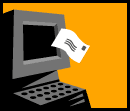
28 Aug E-mail Rules – Quick Reminders to Avoid Mistakes
When you can spend an hour or two (for me it’s more like 3 hours) a day reading, answering, deleting, ignoring and categorizing your e-mails, it is more important than ever that you use your time to wisely handle the impression you give others through your electronic missives. Our e-mails are more often than not the first impression we have of someone who would like to sell something to us, buy something from us or make a worthy connection to us. While you can’t control what others send to you, properly handling your e-mail correspondence sets the impression you give to others.
All over the internet there are “How-to” and “What-not-to-do” lists about handling e-mail but it is still a frequent question we receive from acquaintances and clients alike. Here are 10 reminders to keep in mind.
What is this e-mail explosion? Was there a point in time when the entire world decided to use the Internet as their business communication tool of choice? Are there rules for managing these messages and being a professional and polite user of electronic mail? There are, but not everyone has gotten the word.
1. Omitting The Subject Line.
We are way past the time when we didn’t realize the significance of the subject line. It makes no sense to send a message that reads “no subject” and seems to be about nothing. Given the huge volume of e-mail that each person receives, the subject header is essential if you want your message read any time soon. The subject line has become the hook.
2. Not Making Your Subject Line MeaningfuL.
Your header should be pertinent to your message, not just “Hi” or “Hello.” The recipient is going to decide the order in which he reads e-mail based on who sent it and what it is about. Your e-mail will have lots of competition.
3. Failing To Change The Header To Correspond With The Subject.
For example, if you are writing your web publisher, your first header may be “Web site content.” However, as your site develops and you send more information, label each message for what it is, “contact info,” “graphics,” or “home page.” Don’t just hit “reply” every time. Adding more details to the header will allow the recipient to find a specific document in his/her message folder without having to search every one you sent. Start a new message if you change the subject all together.
4. Not Personalizing Your Message To The Recipient.
E-mail is informal but it still needs a greeting. Begin with “Dear Mr. Broome,” “Dear Jim,” “Hello Jim,” or just “Jim.” Failure to put in the person’s name can make you and your e-mail seem cold. Remember, too, that e-mail is not a memo, it is still mail, similar to what you would send by post but much, much quicker and less expensive.
5. Not Accounting For Tone.
When you communicate with another person face to face, at least 65% of the message is non-verbal. E-mail has no body language. The reader cannot see your face or hear your tone of voice so choose your words carefully and thoughtfully. Put yourself in the other person’s place and think how your words may come across in Cyberspace.
6. Forgetting To Check For Spelling And Grammar.
In the early days of e-mail, someone created the notion that this form of communication did not have to be letter perfect. Wrong. It does. It is a representation of you. If you don’t check to be sure e-mail is correct, people will question the caliber of other work you do. Use proper capitalization and punctuation, and always check your spelling. Remember that your spellchecker will catch misspelled words, but not misused ones. It cannot tell whether you meant to say “from” or “form,” “for” or “fro”, “he” or “the.”
7. Writing The Great American Novel.
E-mail is meant to be brief. Keep your message short. Use only a few paragraphs and a few sentences per paragraph. People skim their e-mail so a long missive is wasted. If you find yourself writing an overly long message, pick up the phone or call a meeting.
8. Forwarding E-Mail Without Permission.
Most everyone is guilty of this one, but think about it. If the message was sent to you and only you, why would you take responsibility for passing it on? Too often confidential information has gone global because of someone’s lack of judgment. Unless you are asked or request permission, do not forward anything that was sent just to you.
9. Thinking That No One Else Will Ever See Your E-Mail.
Once it has left your mailbox, you have no idea where your e-mail will end up. Don’t use the Internet to send anything that you couldn’t stand to see on a billboard on your way to work the next day. Use other means to communicate personal or sensitive information.
10. Leaving Off Your Signature.
Always close with your name, even though it is included at the top of the e-mail, and add contact information such as your phone, fax and street address. The recipient may want to call to talk further or send you documents that cannot be e-mailed. Creating a formal signature block with all that data is the most professional approach.
11. Expecting An Instant Response.
Not everyone is sitting in front of the computer with e-mail turned on. The beauty of Internet communication is that it is convenient. It is not an interruption. People can check their messages when it suits them, not you. If your communication is so important that you need to hear back right away, use the phone.
12. Completing The “To” Line First.
The name or address of the person to whom you are writing is actually the last piece of information you should enter. Check everything else over carefully first. Proof for grammar, punctuation, spelling and clarity. Did you say what needed to be said? How was your “tone of voice”? If you were the least bit emotional when you wrote the e-mail, did you let it sit for a period of time? Did you include the attachment you wanted to send? If you enter the recipient’s name first, a mere slip of the finger can send a message before its’ time. You can never take it back.
E-mail makes everything easier and faster including making a powerful business impression and establishing positive professional relationships. The businessperson who uses the technology effectively and appropriately will see the results of that effort reflected in the bottom line.
If you are interested in Business Writing and how to write better, check this page…
http://www.selfpresentations.com/writing-for-business-results/
